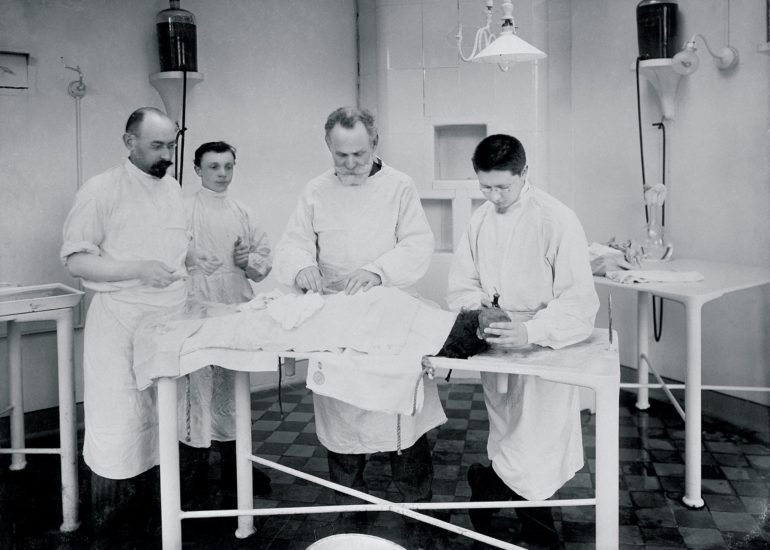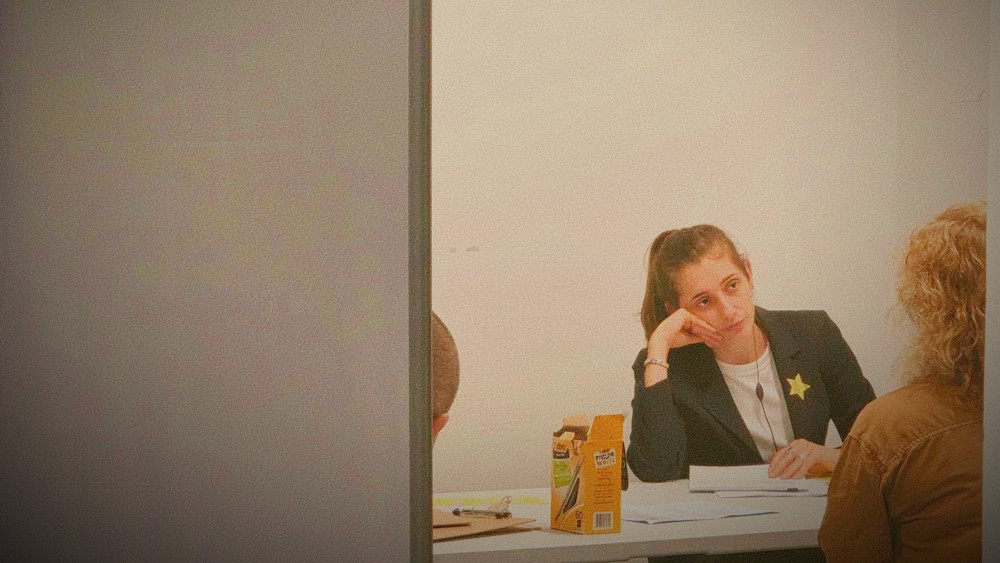Two years ago, at the very start of the pandemic, playwright Sam Chanse sat down with The Civilians’ Susan Yassky to discuss a reading of Sam’s play, WHAT YOU ARE NOW, that had been held in January 2020. On March 9, 2022, WHAT YOU ARE NOW will have its first in-person performance, presented by The Civilians and The Ensemble Studio Theatre. In anticipation of its world premiere, we are revisiting Susan and Sam’s conversation about the writing process, the play itself, and the science behind it. This interview was originally published on April 9, 2020.
For information on our upcoming production of WHAT YOU ARE NOW, click here.

Today, Extended Play is taking a break from our coronavirus content to bring you an interview with playwright Sam Chanse. This interview was conducted in January 2020, after a reading of Sam’s play What You Are Now presented by The Civilians and New Dramatists and directed by Steve Cosson. The play, which was first developed in the 2015-16 R&D Group and as an EST/Sloan Project commission, tells the story of a neurologist named Pia. The daughter of a trauma survivor, Pia is driven by the desire to help free her mother, Chantrea, from paralyzing fear memories. But the unexpected return of an old acquaintance triggers a storm of memory, forcing Pia to tangle with her own fears and paralysis, and pushing her to question deeply-held beliefs about her past. I sat down with Sam to talk about the origins of the play, takeaways from the workshop process, and what draws her to writing plays about science.
This interview has been edited and condensed for clarity.
SUSAN YASSKY: How did you come to start writing this play?
SAM CHANSE: It was a bunch of things coming together that had been stewing in my brain for a while. I’d encountered an essay about the possibility of changing fear memories in people struggling with PTSD—in particular, the possibility of erasing the emotional aspects of a fear memory while preserving the cognitive, factual aspects of the memory. The piece profiled a neuroscientist, Dr. Daniela Schiller, who studies the science of emotions and how emotional memories are formed. She’s the daughter of a Holocaust survivor, and she described growing up with a parent who never shared that part of his history, and wondering about the cost of carrying these debilitating fear memories, and what it would mean if you could change them. The essay resonated with me, and also immediately brought to mind other communities that have suffered a mass trauma, and the ongoing deportation of young Cambodian Americans since the early 2000s, and how this has constituted a double trauma in those communities—enduring a genocide and fleeing your home, and then decades later having your family torn apart again. It made me think about the relationship between a parent and child with that double experience, and the impact of those fear memories. On another level, the piece also made me think about my own relationship to the past, and growing up with the particular silences in my family—what we talked about, what we didn’t talk about, what the temperature was like at home as a kid. And all of that led pretty quickly to the idea of music in counterpoint to silences, and then to the Cambodian pop music that was being made in the 70s. So it was all of these things intersecting which really birthed the play.
SUSAN: You were R&D Group two or three years ago, right?
SAM: A few years ago, yeah.
SUSAN: What was that process like?
SAM: It was great to be in the group and hear about the other projects developing—they were all really different, and exciting in different ways. My process was pretty research heavy—a lot of reading and listening and watching and talking to folks. And then I was writing throughout, and bringing pages in to share with the group. By the end of the year I had a really really messy first draft. Colette Robert directed the final reading at the end of the season, which I remember being something like three hours long. The play is very different now in terms of structure, and in terms of length—it’s shorter, now—and even some of the characters, but that first year is when I located the bones of it.
SUSAN: Has the play always had the structure of calling back to one particular memory?
SAM: Yeah, that was there from the beginning—this idea of having a recurring fear memory—something we think of as a very stable fact of who we are, that defines us in a way—and having that foundational fear memory somehow change. And what was exciting to me, and is exciting to me, is the idea that something very concrete—something that seems permanent and like a fact of who we are, and who we understand ourselves to be—is actually dynamic and can develop and change, even our memories.
SUSAN: Did you learn anything new about the play during this most recent workshop?
SAM: Yeah—so much. It was a pretty amazing process for me, thanks to an incredible group of collaborators—I feel very lucky about who was in the room. The actors were so generous and brave and smart, on top of being fantastic actors, and really allowed for us to hear the play and explore the characters and their journeys. And Steve and Janice [Paran, dramaturg for What You Are Now] were so wonderful to work with as director and dramaturg—I was so grateful for their wisdom and sensitivity and perspective. And really for the collective wisdom and sensitivity and perspective in the room. So there was a ton that was learned.
Thinking of just one thing, something I was really curious to hear was the cumulative impact of the memories. There’s an accretion of memory as the play goes on, and I wanted to see how that was working with the emotional journey. The memories are not just regressive and circular and repetitive, but progressive—even in the same memory repeating itself there is change.
Another thing I was able to hear and learn is what doesn’t need to be in the text. It’s a research-heavy play for me, and I think partially because I was still trying to hold a lot of things together in my head at once and understand them all, I was repeating things over and over to make sure everything was clear. Sometimes the repetition in the play is structural and necessary, but then there are other times where the repetition is just redundant. So that was helpful to hear—that I could trust more in less.
SUSAN: This play and the other play of yours that I know, Trigger, both deal with science, or with a scientific understanding of why we are the way we are. Is Trigger also Sloan-related, or not?
SAM: It’s not. I don’t set out to write plays about science, but I do often wind up writing plays that intersect with something explicitly in the realm of science—which is obviously still a pretty huge realm. I have plays that are tied to concepts about how we’re wired evolutionarily, or some underlying element in the climate or in the environment. One newer play also has a scientist as one of the characters, but one who’s studying coral bleaching and the end of the world. It also involves some of the science of sloths and the symbiotic relationship between sloths and algae. I’m drawn to a lot of concepts I encounter in science—there’s usually some principle that resonates both on its own and as a metaphor for illuminating some aspect of who we are as human beings.
SUSAN: I really admire how much you trust the audience to be ready to follow the science of it. Do you ever feel like, “oh, that ended up going into too much detail”?
SAM: Yeah all the time. I love all the detail and getting really granular with it, and I feel all the science is necessary and integral to the story. But then, it’s hearing it out loud at the end of a process and having some distance that gives me a fresh perspective on it. Working with Janice and Steve was a huge help in this respect, too. When we did the read-through at the end of this last workshop, there were moments where we were like, “oh, that actually is more than we need,” or “that feels like it’s going on a little bit too long”—like maybe we don’t need the name of that particular antibiotic, maybe we don’t to need to hear about zeta inhibitor peptides and all the different ways of interfering with protein synthesis and the chemical processes of memory formation. And I do love all that information, and I do think it’s necessary when I’m writing the early drafts of something—it’s illuminating the story for me, and I need to understand all that material as best as I can when I’m writing. And then as it gets further along in the process, that’s when I start cutting out a lot. Because all the information that was necessary in developing the play and the story is no longer serving the telling of the story—now maybe it’s just distracting from it and getting in the way.
SUSAN: Totally. I’m enough of a nerd about the science that I would find it hard to know what to cut.
SAM: It is hard, and whenever I cut it, I’m like, “oh, but that’s so critical!” But obviously I can’t put everything in.
SUSAN: Yeah, actually I was going to ask, if someone wants to know more about the material, are there books or things that you would recommend?
SAM: For the memory stuff, Kandel has this book called In Search of Memory, which is just this fascinating, beautiful book about how memory functions. He did a lot of work with giant sea snails called aplysia—they were great for studying memory because they have one really large nerve which you can see with the naked eye, so you could watch memories forming. That’s one small part of the book but I always think of it because it’s so cool to me—the idea of being able to literally see a memory form. Aplysia and their crazy giant visible nerve is one of the many things that were initially in the script but removed in later drafts. There’s also a generosity and gentleness about the writing, from what I remember, that I especially appreciated in a book with so much hard science. But yeah, there are other articles and books, too—I can send a list of a few.
SUSAN: The Pavlov thing is so upsetting.
[Pavlov’s experiments involved a process called “sham feeding,” in which he would remove a dog’s esophagus so that, no matter how much the dog ate, the food would never make it to the stomach. Read more about Pavlov’s gruesome experiments here.]
SAM: It’s so upsetting.
SUSAN: And it’s so good to have it in the play, as a reminder that sometimes very upsetting things happen in order to perform these studies.
SAM: It’s a troubling context, which I think is important to hold onto. Also the Little Albert experiment, that’s horrifying. I wonder about how that experience impacted that kid growing up. But they did so many experiments like that, just kind of fucked with people, in otherwise well-intended efforts to advance scientific understanding. And those advances in understanding have had an immense and positive impact on people, but then of course there have also been real, terrible costs.
SUSAN: One thing in the play that stood out to me when I was watching it on Friday was the shifting views that Chantrea’s children, Pia and Darany, have of her, thinking of her either as someone who’s very impaired and paralyzed, or feeling like that’s condescending to her and not giving her enough credit. Why do they shift back and forth about that? What’s appealing about each view for them?
SAM: Recognizing that their mother does struggle with PTSD is valuable and necessary—it can affirm that she’s not crazy for struggling with it, that they’re not crazy for recognizing it, that this isn’t necessarily the way things should be. And in general of course it’s important to recognize so that you can take care of yourself and take care of each other, and maybe do something to treat it and help with healing. But I think Darany is also right—to say that she’s paralyzed isn’t giving credit to how much she does. It’s equally important to affirm that she is a survivor, that she is still active and engaged in the world, and that she wasn’t defined or destroyed by the trauma. It’s somewhere in between where things probably live. To say she has no problems, that she’s working at a job, she’s fine, she’s got a community, is to negate the real impact of the experience, and the ongoing impact. And to say all she is is trauma is also negating that she’s a living person who survived something and has achieved a lot and continues to achieve a lot.
There’s a scene where we only see Chantrea, in the past, where she’s talking to a monk. I actually don’t know if this scene will survive the next draft, but one of the reasons I care about this moment is that it’s a moment where we see her not through the gaze of her children.
Further Reading / Watching / Listening for “What You Are Now”
Reads:
- Eric Kandel’s In Search of Memory: The Emergence of a New Science Mind
- Michael Spector’s New Yorker essay, “Partial Recall”
- Marianne Hirsch’s “The Generation of Postmemory: Writing and Visual Culture After the Holocaust”
Views/Listens:
- Eternal Sunshine of the Spotless Lab Rat (Radiolab)
- Karim Nader Ted Talk: Memory Manipulation
- The Complexity of Memory (a playlist)
- Nicole Newnham & David Grabias’ Sentenced Home
- John Pirozzi’s Don’t Think I’ve Forgotten: Cambodia’s Lost Rock & Roll
Extended Play is a project of The Civilians. To learn more about The Civilians and to access exclusive discounts to shows, visit us and join our email list at TheCivilians.org.
Author
-

Susan Yassky is the Literary Associate for The Civilians and a New York City-based playwright and dramaturg. She was a Dramaturgy and Literary Management Apprentice at Actors Theatre of Louisville, where she worked on several productions in the 2019 Humana Festival of New American Plays. As a literary intern, she has worked at the Vineyard Theatre, Long Wharf Theatre and the York Theatre Company. Her plays have been developed at Actors Theatre of Louisville and Yale University. She received her B.A. in Theater Studies and Humanities from Yale in 2017. https://www.susanyassky.com
View all posts









